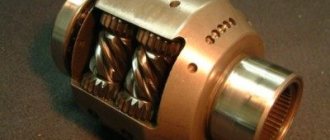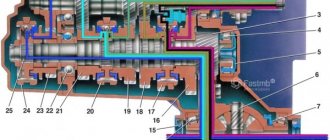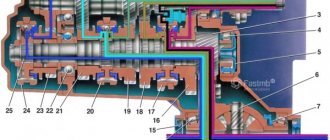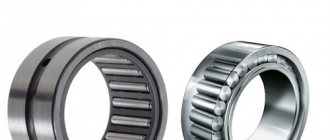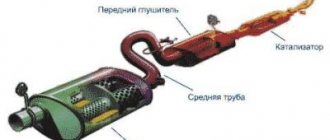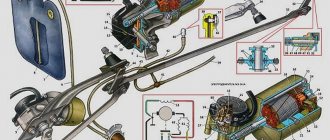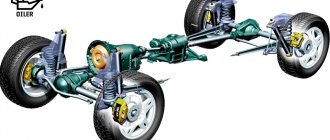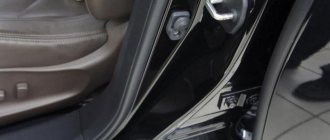Recently, SUVs and crossovers with all-wheel drive have become very popular.
If previously preference was given only to cars with high ground clearance, now the presence of a 4x4 transmission is a priority. But such technology can be implemented in completely different ways; let’s look at the structural features of the center lock and clutch on a Chevrolet Niva car.
How does the Niva distribution box work?
There are three such differentials in the Niva transmission: each axle has its own (interaxle) so that the wheels of the axle can rotate at different speeds, and the third (interaxle) - in the transfer case - distributes the traction force between the axles. ... And this knob controls the operation of the transfer case differential.
Interesting materials:
How to smooth out rough edges in Photoshop? How to hit your top serve hard in volleyball? How to sync Chrome and Firefox? How do weather forecasters determine air temperature? How do family scandals affect a child? How to scan with a Brother printer? How to scan iPhone WhatsApp QR code? How do you say fool in another way? How to tell a guy that he is good in bed? How to upload a large video to Facebook?
How all-wheel drive works on Lada 4×4 and Chevrolet Niva
All-wheel drive on the Niva is permanent. Under normal road conditions, the vehicle drives with the differential unlocked. The differential lock must be turned on when driving on difficult terrain, snow, ice, mud, or when there is a high probability of wheel slipping. If one wheel on the front and rear axles is slipping, locking the differential will not solve the problem; only the suspended wheels will rotate.
The front and rear axles are controlled using a transfer case. The front lever is responsible for engaging the differential lock. By moving the rear handle back and forth, you can engage a lower or higher gear. These controls emphasize that the Lada4×4 and Chevrolet Niva are full-fledged SUVs, and not just cars with four-wheel drive.
The transfer case does not have synchronizers. When shifting, the gears align their teeth to each other; to engage the gear, you need to move the car a little back or forward.
The Niva's front and rear axle differentials are non-locking and redistribute rotational motion automatically. The driver can only lock the center differential.
When the center differential is locked, the same angular velocity is transmitted to the front and rear axles. This increases the vehicle's cross-country ability.
You need to lock the center differential when approaching a difficult section of the road, before the car begins to slip. Mud, sand, snow, ice are surfaces on which the risk of slipping is high; it is better to prepare to overcome such obstacles in advance. When the differential is locked, at least one wheel will rotate on the rear and front axles. But it is worth knowing that if the wheels of the rear and front axles are suspended diagonally or on one side, the differential lock will not solve the problem - the car will not be able to continue moving.
Do not lock the differential on asphalt and other smooth, hard road surfaces. This increases fuel consumption, accelerates tire wear and increases the load on vehicle parts.
What is the difference between Chevrolet Nivas of different modifications?
The Niva is produced on the territory of the Russian Federation by specialists from the GM-AvtoVAZ company . The first concept, number 2123, was first demonstrated in 1998. The model was considered a successor to the VAZ-2121.
Restyling affected only the body . Spaciousness and modernity are its main advantages. The manufacturer's tasks included:
- providing complete comfort for the driver and passengers;
- increase in wheelbase.
Due to the 1998 crisis, car assembly was done manually . After purchasing the plant, General Motors in 2002 created a new look. The Niva was produced with a radiator, a golden cross and received a new name - Chevrolet Niva.
The SUV was produced in 2 main trim levels:
- L: electric windows, heated exterior mirrors (since 2004)
- GLS: faux leather interior, 16-inch alloy wheels, audio equipment, isothermal tinted windows, fog lights, heated front seats.
The car was equipped with a 4-cylinder engine with a volume of 1.7 liters . A fuel injection system is provided. The maximum torque corresponds to 128 Nm. Since November 2006, the automaker has released the first Chevrolet Niva FAM-1 in one configuration: GLX.
Differences between the new product and its predecessor:
- Opel Z18XE 1.8 liter engine;
- 5-speed manual transmission Aisin AG5 from Suzuki Grand Vitara;
- transfer case located in the same block with the gearbox.
The car was produced with 2 airbags, an ABS system from Bosch, a 10-inch brake booster, and Turkish CV joints. The model has been discontinued since 2008.
As a result of tuning, engineers were able to create a new look for Chevrolet ˗ Trophy . The model is maximally adapted for off-road use. Its differences from the basic configuration:
- breathers are located under the hood;
- drive axles are equipped with self-locking differentials with high friction;
- a mechanism that allows you to secure an electric winch.
There was a breakdown
The front axle (Niva) often requires replacement, the price of which sometimes reaches 20,000 rubles, for those people who are constantly trying to improve their car or reduce its consumption. The actions of amateurs lead to increased wear of one or another bridge, and sometimes both at once. However, the bridge does not always fail due to human intervention, because no one has canceled simple breakdowns and wear of parts.
It's okay if you've never seen the front axle, Niva will forgive you for that. The sound will immediately let you know about a breakdown - increased noise, squealing and squeaking will be difficult to miss. Another common problem is oil leakage, but this problem can easily be identified during a technical inspection. It is easy to understand that noise occurs when there is poor engagement, wear of bearings and gears, as well as physical damage to the bridge, which is extremely unlikely, but still possible.
How to remove the front axle gearbox of a VAZ-21213 car
Before removing, clean the gearbox from dirt. We install the dismantled gearbox on a workbench.
Using a 10mm spanner, unscrew the eight nuts securing the front cover to the gearbox housing.
Using a 10mm socket, unscrew the bolt securing the locking plate of the left differential box bearing cover...
...and remove the plate. Similarly, remove the locking plate of the right cover.
Using a 19mm socket, unscrew the four nuts securing the differential box bearing caps.
Removing the front axle gearbox
We carry out the work on a lift or inspection ditch.
Drain the oil from the front axle gearbox (see Changing the oil in the front axle gearbox). We disconnect the driveshaft from the front axle gearbox (see Removing the driveshaft). We dismantle the right drive (see Removing the front wheel drives). Disconnect the lower left ball joint from the lever (see Removing the lower ball joint). Remove the left front suspension brace (see Removing the brace).
Using a 13 mm spanner, unscrew the three nuts securing the bearing cover of the left drive inner joint housing to the front axle gearbox.
Use a spatula to pry off the bearing cover.
...and, pulling the steering knuckle with the drive to the left, we remove the splined part of the housing of the internal drive joint from the hole in the gearbox housing.
We move the housing of the internal drive joint back.
to the cylinder block bracket...
...and to the left engine mount bracket.
Having removed the stop from under the gearbox,...
Install the gearbox in reverse order.
The front axle structure is shown in Fig. 3-81. To distinguish it, a mark in the form of the number “13” is applied to the gearbox housing with paint.
1 — mud deflector; 2 — lower cover of the gearbox housing; 3 — drive gear bearings; 4 — differential housing; 5 — drain plug; 6 — filler and control hole plug; 7 — bearing of the internal hinge housing; 8 — oil seal; 9 — housing of the internal wheel drive hinge; 10 - spring washer;
11 — retaining ring; 12 — bearing cover; 13 — adjusting nut; 14 — differential box bearing; 15 — bearing cover; 16 — cover fastening bolt; 17 — support washer; 18 — axle gear; 19 — satellite; 20 — gear housing; 21 — breather; 22 — front axle mounting bracket;
The front axle gearbox of the Niva VAZ-21213 car is removed for repair work, when it is necessary to correct the defects that we discussed in the article - “Features of the front axle of the VAZ-21213”.
The work must be done on a lift or inspection pit.
We prepare the car for work.
We drain the oil from the front axle crankcase (see the article - “Changing the front axle oil”).
We dismantle the driveshaft (see the article - “Removing driveshafts”)
We remove the right-hand drive (article – “Removing and installing front wheel drives”)
— hang out and remove the left front wheel;
— unscrew the adjusting nut of the front hub bearings;
1. Using a 22mm spanner, unscrew the nut securing the ball joint to the steering knuckle.
2. Place the stop under the lower arm and use a 13mm wrench to unscrew the 3 nuts on the bolts securing the ball joint to the lower arm, holding the bolts with a second wrench.
Resource of transmission elements
With proper maintenance, all transmission elements have service lives that comply with the regulations. The existing stereotype about unreliability is not confirmed either documentary or practically. Until now, the Chevrolet Niva remains one of the most popular cars on the market. The owners claim that the car is taking care of its 200,000 km, which the plant lays down as a resource. This means that the transmission resource is determined by the manufacturer and cannot be less than 200,000 km.
Once again, emphasis should be placed on timely maintenance as a guarantee of flawless operation of the system.
Drive device.
The classic Niva 2121 became the first Russian SUV to be equipped with an all-wheel drive transmission. Among the main features of this transmission was the ability to lock the center differential. Many people mistakenly believe that this unit is necessary to connect the front axle. But in reality, the front axle is always in the connected position. Let's try to understand the design of the car in more detail.
The chassis of the car is designed in such a way that torque from the engine is transmitted through the gearbox to all 4 wheels at once. This operating scheme allows you to show the best performance when moving off-road, while at the same time significantly reducing the cost of the main parts.
Advantages of Lada 4×4 and Chevrolet Niva cars
Why have these inconspicuously designed cars remained so popular over the years? The secret is the relatively low cost, which is combined with good maneuverability, reliability and simplicity of design. Many people appreciated this vehicle during trips to hunting, fishing, and off-road travel.
Of course, Lada4×4 and Chevrolet Niva have many disadvantages. They are inferior in many respects to modern SUVs, which are distinguished by increased comfort and the presence of many additional options, but for those who are looking for an inexpensive, easy-to-repair car with high cross-country capability, the Niva is a pretty good option.
Lada 4×4
Chevrolet Niva
Location of levers on Lada 4×4
Transmission units
Differential locations
edit this post
Power steering
The car is equipped with power steering, which significantly reduces the force on the steering wheel. If the power steering is not functioning (for example, when towing a vehicle with the engine not running), you can still steer the vehicle, but you will need to apply significantly more force to the steering wheel to do so. In extreme positions of the steering wheel, functional noise is allowed.
Warning
- Do not coast with the engine not running! In this case, the power steering does not work, putting you and other road users at risk.
- It is not allowed to hold the steering wheel in extreme positions for a long time.
Tips for operating Lada 4×4 and Chevrolet Niva
Beginners do not immediately remember at what position of the handle the differential is locked. But this is indicated by a warning indicator on the dashboard. If it lights up, the differential is locked. The front handle of the transfer case is responsible for locking the differential. If it is in the forward position, the differential is unlocked, in the rear it is locked.
The rear handle allows you to engage a lower gear. This must be done before getting into difficult road conditions. Since the box does not have synchronizers, switching must be done when the car is stationary. In this case, you need to depress the clutch. If the switch does not occur, you need to slowly move away, shaking the steering wheel.
When driving on a flat road, the rear transfer case handle should be in the rear position, and the front handle should be in the forward position.
What to do if the front and rear wheels are hanging out? As mentioned above, even locking the differential will not help solve this problem; the car will not move. To set the car in motion, you can pour soil under one of the hanging wheels. If there are passengers in the car, you can move them to the rear or front of the car by loading one of the axles.
Features and malfunctions of the transfer case
The Chevrolet Niva transfer case not only moved back by 250 mm, but also changed the installation angle by 4 degrees. Chevrolet engineers calculated that this angle would be optimal for the operation of driveshaft joints. The design of the transfer case uses small-module, low-noise gears, so the howling of the transfer case, as on the old Niva, is now completely eliminated.
Another common malfunction of the transfer case on old Nivas was vibration. On Chevrolet, this issue has been practically resolved by installing new pillows and the appearance of a third attachment point. This will eliminate not only operational vibrations and noise, but also the likelihood of incorrect installation of the transfer case after repair, prevention or troubleshooting.
There is another malfunction that few people think about, however, this problem is related to the resource and endurance of constant velocity joints. The fact is that a cermet valve is installed directly under the CV joint boot mounting clamp. Its task is to compensate for excess pressure inside the cover, thereby protecting it from rupture, and the CV joint itself from water and dirt. If you monitor the performance of the cermet valve during repairs or replacement of hinges, the boot will last a long time and will reliably protect the CV joint.
Even such a complex system as the Chevrolet Niva transmission can be succinctly described in an accessible way. Each owner is required to know the basic principles of operation of the systems of his car.
Making a Niva 2121 elevator with your own hands, drawings, dimensions
We will tell you how to properly perform tuning modifications in this material. Do-it-yourself elevator - drawings, diagrams, sizes, types of kits. Lifting varies in the degree of intervention in the standard structure. For some, it is enough to raise the SUV by a few centimeters, and for others by as much as 20.
Extreme tuning – maximizing cross-country ability for traveling on severe off-road conditions.
- Regular jack
- Hijack jack
- Spring puller
- Balloon wrench
- Ratchet socket set
- Set of open-end wrenches
- Mount
- Wooden deck (stump)
Raise the front end. You can safely cling to the standard bumper, only the jack is installed under the pipe securing it. By removing the wheel, we get full access to the lever and spring. The front suspension 21214 is made using a double wishbone design, which simplifies the task.
The lever travel is limited by the shock absorber. Unscrew its fastening and move it to the side. Next you need to free the suspension from the anti-roll bar. The mounting bolts may become stuck due to corrosion, so we will use a penetrating liquid (such as WD-40). The stabilizer silent block clamp can be pryed off with a pry bar.
Then disconnect the hub from the lower arm. To do this, you need to jack up the suspension and fix the steering knuckle of the wheel. You can tie it with wire. Then unscrew the 3 mounting bolts and release the ball joint.
Remove the upper support rings from the old springs. With their help, the elastic element is centered in the cups.
They come together easily with a hammer and screwdriver. We install the rings on new, longer springs. We put the elastic elements in their regular places and jack up the lower arm until it is completely aligned with the lower cup. At the same time, an assistant centers the shock absorber eye and moves the steering knuckle to the mounting location of the lower ball joint. We tighten the ball “triangle” and attach the shock absorber mounting axis.
By manipulating the jack, we “catch” the mounting holes for the stabilizer bar clamp. With its bolts it should get into the normal place without distortion. After such modernization, the clearance increases by 30-50 mm. This is enough to install wheels of larger diameter, and the bottom will still rise above the ground.
The rear axle of the Niva can be lifted by installing spacer supports of increased height. When using a size of up to 50 mm (according to changes in front end height), no modifications to the rear axle are required. By lifting the rear axle, maintenance can be carried out on the axle and brake system.
The handbrake cable may need to be replaced. It is lengthened by a couple of centimeters. Otherwise, the Niva lift will lead to increased wear of the brake pads in the rear drums. Disconnect the lower shock absorber mounts and lower them until the springs stretch.
Such a lift will not arouse suspicion among traffic police inspectors, and the cross-country ability of your NIVA 2121 will improve. No drawings, much less homemade parts, are required. You buy new springs and about the rates, the rest is a matter of technology. Labor costs for an elevator of one NIVA are two people/one day off.
Also interesting: ❶ How to increase the cross-country ability of the Niva
